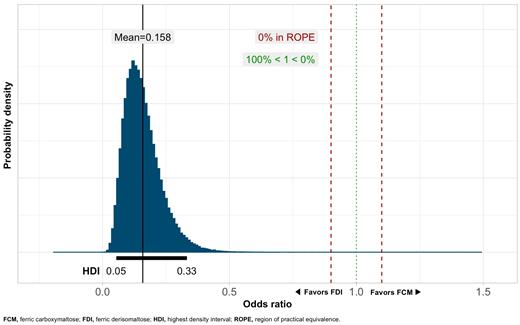Abstract
Background and Aims
Intravenous (IV) iron is the preferred treatment for patients with iron deficiency (ID) and iron deficiency anemia (IDA) in a variety of clinical situations. Although uncommon, administration of modern IV iron formulations can result in hypersensitivity reactions and, very rarely, anaphylactic reactions. The objective of the present study was to systematically review the literature to identify and analyze data on the incidence of serious or severe hypersensitivity reactions (HSRs) after administration of different IV iron formulations.
Methods
A prospectively-registered systematic literature review (SLR) was conducted to identify prospective, active comparator randomized controlled trials (RCTs) comparing ferric derisomaltose (FDI) (also known as iron isomaltoside 1000) or ferric carboxymaltose (FCM) with other IV iron formulations or oral iron. The primary endpoint was the incidence of serious or severe hypersensitivity reactions occurring on the day or day after dosing of IV iron, based on pre-specified terms (MedDRA classification).
Results
Data were obtained from ten prospective, active comparator RCTs of FDI (N=3,474) and seven prospective, active comparator RCTs of FCM (N=2,683), two of which were head-to-head comparisons of FDI and FCM. The trials enrolled a total of 10,467 patients, of whom 6,157 were treated with either FDI or FCM. The number of patients experiencing any serious or severe hypersensitivity reactions was 5/3474 with FDI (0.14%) versus 29/2683 (1.08%) with FCM; Bayesian inference of proportions showed the reaction rates to be significantly lower with FDI relative to FCM (Figure).
Conclusions
To our knowledge, the present analysis represents the first SLR and meta-analysis of the incidence of serious or severe HSRs after administration of FDI vs FCM based on pre-specified MedDRA terms. The SLR conducted for the present meta-analysis, identified 15 prospective, head-to-head RCTs including 10,467 patients, of whom 3,474 and 2,683 were treated with FDI and FCM, respectively. The analysis demonstrated that serious or severe hypersensitivity reactions were uncommon with the newer high-dose IV iron formulations; and showed a significantly lower incidence of serious or severe hypersensitivity reactions with FDI compared to FCM.
Biggar: Vifor-Fresenius: Consultancy; Pharmacosmos: Consultancy; Medice: Consultancy. Pöhlmann: Pharmacosmos A/S: Consultancy. Pollock-Wilkins: Pharmacosmos A/S: Consultancy.


This feature is available to Subscribers Only
Sign In or Create an Account Close Modal